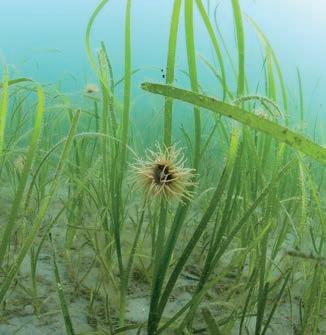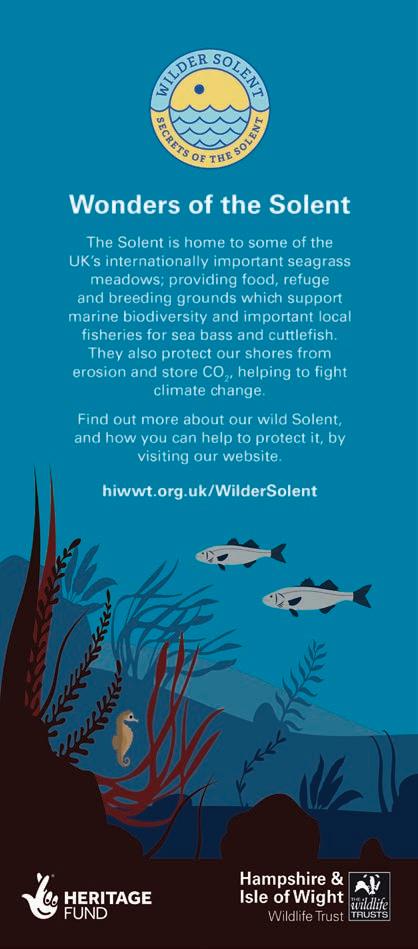
4 minute read
Wildlife: with Hampshire and Isle of Wight Wildlife Trust
WITH HAMPSHIRE AND ISLE OF WIGHT WILDLIFE TRUST
Snakelocks anemone on seagrass. Image: Tim Ferrero HIWWT
Advertisement
The Solent is a landmark in British waters as the home of the Royal Navy, an important gateway for shipping and trade, and a famous hub for recreational boating and other watersports. Less well known are its internationally important protected wildlife and habitats, including its wonderful seagrass meadows. Seagrasses are the only marine flowering plants and support rich biodiversity, including amazing species like seahorses, spider crabs and pipefish.
An important asset for local fisheries, seagrass meadows provide nursery and foraging areas for species like sea bass, which spend up to seven years growing in the Solent and its estuaries before joining the adult population. Cuttlefish also visit the area every spring and summer to breed, attaching their dark black eggs, known as sea grapes, to the long leaves of the plants.
Seagrass meadows are an incredibly important asset in the fight against climate change – absorbing and storing carbon dioxide in huge quantities, locking it away in the muds and sands they grow upon. They are one of the most efficient carbon-storing habitats on Earth, performing better than tropical rainforests. In fact, despite only covering about 0.1% of the seabed, seagrass meadows are responsible for sequestering up to 18% of all oceanic carbon. They
Eelgrass. Image: Paul Naylor

also improve water quality by absorbing excess nutrients from sewage and agricultural runoff and provide natural coastal protection by absorbing wave energy.
These vitally important habitats are at risk from pollution, human activities and the effects of climate change and coastal squeeze. We know that the Solent used to support more seagrass than it does today. Historic records suggest that there were once seagrass meadows all the way along Southampton Water and the Hamble as far as Bursledon. But through the 1930s a wasting disease caused the widespread decimation and destruction of one of our native seagrass species, Zostera marina.
The disease outbreak destroyed up to 95% of all known seagrass beds in the North Atlantic and recovery since that time has been weak. There have been further disease outbreaks - the cause of which has now been identified as a slime mould, Labyrinthula zosterae - and the re-establishment of seagrass meadows has been hindered by other pressures. Seagrasses have been severely impacted by reduced water quality and damaging fishing methods. Fishing trawls and shellfish dredges which are dragged along the seabed can tear up the vulnerable network of roots from which the seagrass grows and, once damaged, recovery can be very slow, if it occurs at all.
But there is some good news. Today, almost all of the Solent’s seagrass meadows lie within Marine Protected Areas (MPAs). The Solent’s MPAs consist of Special Protection Areas (SPA) for birds and Special Areas for Conservation (SAC) for habitats and species that were designated under the European Birds and Habitats Directives; and our four new Marine Conservation Zones (MCZs) that were designated between 2016-2019 under the UK Marine and Coastal Access Act.
Seagrass at Osborne Bay. Image: Tim Ferrero HIWWT

As a result of these protections, much of the Solent’s most sensitive habitats lie within a fisheries byelaw which has, since 2014, made it illegal to use damaging fishing dredges and bottom trawls inside seagrass meadows. Even the wasting disease appears to have lost some of its virulence. There is still more to be done to ensure the future of these fantastic habitats, but it is an exciting time as the prospect of better protection, natural regrowth and even restoration come closer to being realised.
Today, the Solent’s seagrass meadows can be found in mostly shallow waters (less than 5 metres deep) and in intertidal areas on the north coast of the Isle of Wight as far as Bembridge, inside the Solent harbours of Portsmouth, Langstone and Chichester, and close to the entrance to Southampton Water.
Visitors to the Solent can play their part by enjoying the area and its wildlife responsibly. Boaters can play an important role in helping to protect seagrass meadows, which can be damaged by poor anchoring and some types of moorings. The RYA Green Blue has some great advice on their website, and this year you may hear more about the ReMEDIES project, led by Natural England, which is promoting innovative new ways to protect seagrass from damage by traditional moorings and other activities like anchoring and bait digging.
At the Hampshire and Isle of Wight Wildlife Trust, we are working to promote and protect the wonderful marine habitats and wildlife on our doorstep through our Secrets of the Solent project. We want to see a Wilder Solent that is well protected, more diverse, and an even better place to visit and enjoy, but we need everyone’s help.
Find out more about our wild Solent and how you can help to protect it by visiting our website. hiwwt.org.uk/WilderSolent











